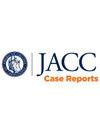Antineutrophil Cytoplasmic Antibody Negative Eosinophilic Granulomatosis With Polyangiitis (Churg-Strauss) Presenting as Acute Decompensated Heart Failure
Q4 Medicine
引用次数: 0
Abstract
Background
Eosinophilic granulomatosis with polyangiitis (EGPA) is a chronic inflammatory condition with eosinophilic infiltration of the respiratory system, heart, peripheral nerves, integumentary system, and gastrointestinal tract.
Case Summary
A man in his mid-60s presented with a 3-month history of progressive dyspnea. He was found to have a large pleural effusion. Over the subsequent 3 months, dyspnea returned, and echocardiography demonstrated left ventricular hypokinesis with an ejection fraction of 40%. He was later admitted for altered mental status and found to have an elevated total eosinophil count with negative antineutrophil cytotoxic antibodies. Repeat echocardiography revealed ventricular thrombi and ejection fraction of 20%. Endomyocardial biopsy revealed eosinophilic infiltration, necrosis, and fibrosis. He was treated with oral prednisone and intravenous cyclophosphamide for 6 months and maintained on oral azathioprine and prednisone.
Discussion
Antineutrophil cytotoxic antibody–negative EGPA is associated with a cardiac-predominant presentation, which is effectively treated with induction and maintenance immunosuppression.
Take-Home Message
Cardiac involvement should be further evaluated on recognition of EGPA.
抗中性粒细胞胞浆抗体阴性的嗜酸性肉芽肿病伴多血管炎(Churg-Strauss)表现为急性失代偿性心力衰竭
背景嗜酸性肉芽肿病合并多血管炎(EGPA)是一种慢性炎症性疾病,嗜酸性粒细胞浸润呼吸系统、心脏、周围神经、肠系统和胃肠道。病例总结:男性,60岁左右,有3个月进行性呼吸困难病史。他被发现有大量胸腔积液。在随后的3个月里,呼吸困难复发,超声心动图显示左室运动不足,射血分数为40%。他后来因精神状态改变而入院,发现嗜酸性粒细胞总计数升高,抗中性粒细胞细胞毒抗体阴性。重复超声心动图显示心室血栓和射血分数为20%。心内膜活检显示嗜酸性粒细胞浸润、坏死和纤维化。患者口服强的松和静脉注射环磷酰胺6个月,并维持口服硫唑嘌呤和强的松。抗中性粒细胞细胞毒抗体阴性的EGPA与心脏为主的表现有关,可通过诱导和维持免疫抑制有效治疗。心脏受累应进一步评估识别EGPA。
本文章由计算机程序翻译,如有差异,请以英文原文为准。
求助全文
约1分钟内获得全文
求助全文
来源期刊

JACC. Case reports
Medicine-Cardiology and Cardiovascular Medicine
CiteScore
1.30
自引率
0.00%
发文量
404
审稿时长
17 weeks
 求助内容:
求助内容: 应助结果提醒方式:
应助结果提醒方式:


